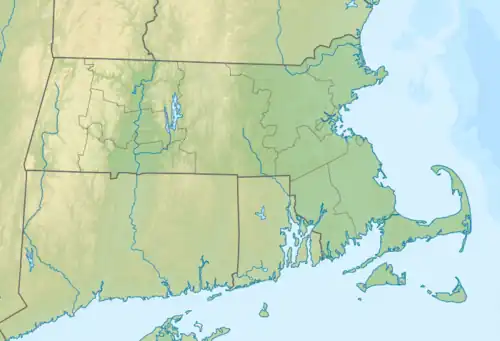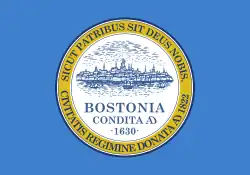| Jamaica Pond | |
|---|---|
 Jamaica Pond, boathouse in distance, 2005 | |
 Jamaica Pond | |
| Location | Jamaica Plain, Massachusetts |
| Coordinates | 42°19′0″N 71°7′13″W / 42.31667°N 71.12028°W |
| Type | kettle pond |
| Primary outflows | Muddy River |
| Surface area | 68 acres (28 ha) |
| Max. depth | 53 feet (16 m) |
Jamaica Pond is a kettle lake, part of the Emerald Necklace of parks in Boston designed by Frederick Law Olmsted. The pond and park are in the Jamaica Plain neighborhood of Boston, close to the border of Brookline. It is the source of the Muddy River, which drains into the lower Charles River.USGS 2005
The pond has an area of about 68 acres (28 ha), and is 53 feet (16 m) deep at its center (MassWildlife map), making it the largest body of fresh water in Boston, and the largest natural freshwater body in the lower Charles River watershed. It is ringed by a 1.5-mile (2.4 km) walking path, and is an extremely popular destination for Bostonians for walking, fishing, rowing, and sailing. Around Halloween each year, the pond serves as the site for The Lantern Parade. Participants dress in their Halloween costumes and walk around the pond.
The pond once served as a reservoir for the City of Boston and the Town of West Roxbury, and it supplied ice in the winter to Boston and beyond.[1]
According to the USGS, the name Jamaica derives from an Indian name meaning "abundance of beavers".[2]
The pond's setting, Jamaica Park, was included in the Olmsted Park landscape complex that was placed on the National Register of Historic Places on December 8, 1971.[3]
History
The Jamaica Plain Ice Company employed 350 men in 1874, and harvested as much 5,000 tons of ice a day from Jamaica Pond.[4]
The pond was once the site of a popular annual winter skating carnival. In 1929, this carnival was cancelled by Mayor Curley when cracks appeared on the ice, and 50,000 skaters had to be evacuated.[5] In recent years, ice skating is no longer permitted on the pond.
Overlooking Jamaica Pond until its 2007 demolition was Pinebank Mansion, the summer home of Edward Newton Perkins.
Gallery
.jpg.webp) Skating on the pond, 1859
Skating on the pond, 1859 Ice delivery van, 1890
Ice delivery van, 1890 Swans, 2010
Swans, 2010 Sailboat on pond, 2013
Sailboat on pond, 2013 Bicyclists, 2021
Bicyclists, 2021 Walking path, 2021
Walking path, 2021 Fishing, 2021
Fishing, 2021 Rowboat, 2021
Rowboat, 2021 Renting a sailboat, 2021
Renting a sailboat, 2021
References
- Water resources and the urban environment, lower Charles River Watershed; ISBN 1-4289-8365-1
- Weiskel, Peter K.; Barlow, Lora K.; Smieszek, Tomas W. (2005). "Water Resources and the Urban Environment, Lower Charles River Watershed, Massachusetts, 1630–2005" (PDF). Reston, Virginia: U.S. Geological Survey. Retrieved February 4, 2014.
- ↑ "Harvesting Ice on Jamaica Pond". Jamaica Plain Historical Society. Retrieved 13 June 2021.
- ↑ U.S. Geological Survey Geographic Names Information System: Jamaica Pond
- ↑ "National Register Information System – Olmsted Park System (#71000086)". National Register of Historic Places. National Park Service. January 23, 2007. Retrieved December 17, 2022.
- ↑ Rosenberg, Charlie (Nov 2007). "Jamaica Plain Historical Society 'Locales' Editor, Harvesting Ice on Jamaica Pond". Jamaica Plain Historical Society. Archived from the original on October 22, 2010. Retrieved June 4, 2010.
- ↑ Remember Jamaica Plain? Fifty Thousand on Jamaica Pond Ice? Wow!
